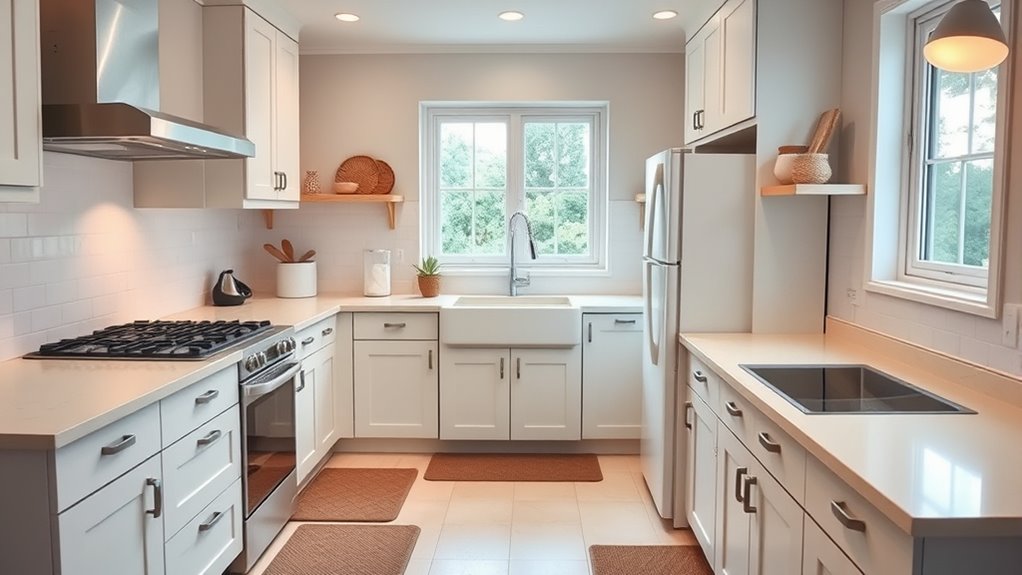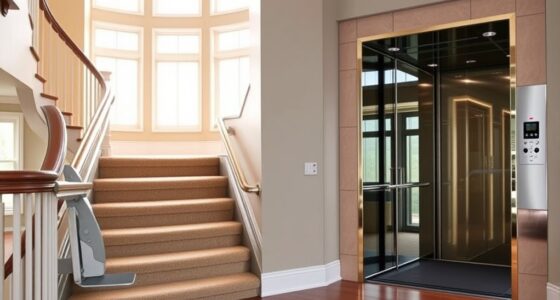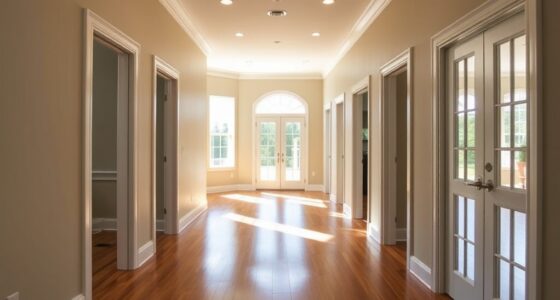To set up a senior-friendly kitchen work triangle, position your sink, stove, and refrigerator to minimize movement and form an efficient shape. Keep pathways at least 36 inches wide, and place frequently used items within easy reach at waist level. Use non-slip flooring, good lighting, and ergonomic handles for safety and comfort. Incorporate adjustable surfaces and flexible storage solutions. Continue exploring these tips to create a safer, more accessible kitchen tailored to your needs.
Key Takeaways
- Position the sink, stove, and refrigerator to form a compact triangle with minimal walking distance.
- Ensure all appliances and work surfaces are at accessible, waist-level heights for ease of use.
- Maintain clear, wide walkways (at least 36 inches) to facilitate safe movement.
- Incorporate good lighting, including task and under-cabinet lighting, to reduce shadows and improve visibility.
- Use non-slip flooring and textured countertops to enhance safety and reduce fall risks.
Understanding the Principles of the Kitchen Work Triangle

Understanding the principles of the kitchen work triangle is essential for creating a functional and efficient space, especially for seniors. This concept connects the three main work areas: the sink, stove, and refrigerator, forming a triangle that minimizes movement. When planning your kitchen, consider how color schemes can influence visibility and mood—opt for high-contrast colors to enhance clarity. Lighting considerations are equally important; ensure bright, even lighting over key zones to reduce shadows and prevent accidents. Use task lighting near counters and under cabinets, and incorporate adjustable fixtures if possible. By understanding these principles, you’ll create a space that’s not only efficient but also safe and comfortable, making everyday tasks easier and more enjoyable for seniors.
Assessing Space and Layout for Accessibility

To create an accessible kitchen, start by carefully evaluating the available space and layout to guarantee ease of movement and safety. Consider the width of walkways—aim for at least 36 inches—to prevent congestion. Assess your countertop materials; non-slip surfaces like textured or matte finishes reduce the risk of slips and falls. Good lighting arrangements are essential; ensure task lighting over countertops and work areas to reduce eye strain and improve visibility. Bright, well-placed lighting also highlights potential hazards. Check that frequently used items are within easy reach, minimizing the need for stretching or bending. By paying attention to space, countertop materials, and lighting, you set the foundation for a safe, senior-friendly kitchen that promotes independence and comfort. Implementing vertical storage solutions can further optimize space and enhance accessibility.
Optimal Placement of Key Appliances and Fixtures

Placing key appliances and fixtures within easy reach is essential for a senior-friendly kitchen. Start by positioning appliances at an accessible height—avoid high cabinets or deep drawers that require stooping or stretching. Countertop appliances like microwaves and coffee makers should be at waist level for easy access. Proper lighting placement is equally important; ensure task lighting is focused on work areas and avoid shadows that can cause accidents. Use under-cabinet lighting to illuminate countertops and prevent glare. Switches and controls should be easy to operate, ideally at a height that doesn’t require bending or reaching overhead. Additionally, choosing appliances with user-friendly controls can further enhance safety and ease of use. By thoughtfully placing appliances and fixtures, you create a safer, more comfortable space that minimizes effort and reduces risk during daily tasks.
Ensuring Adequate Counter Space and Reachability
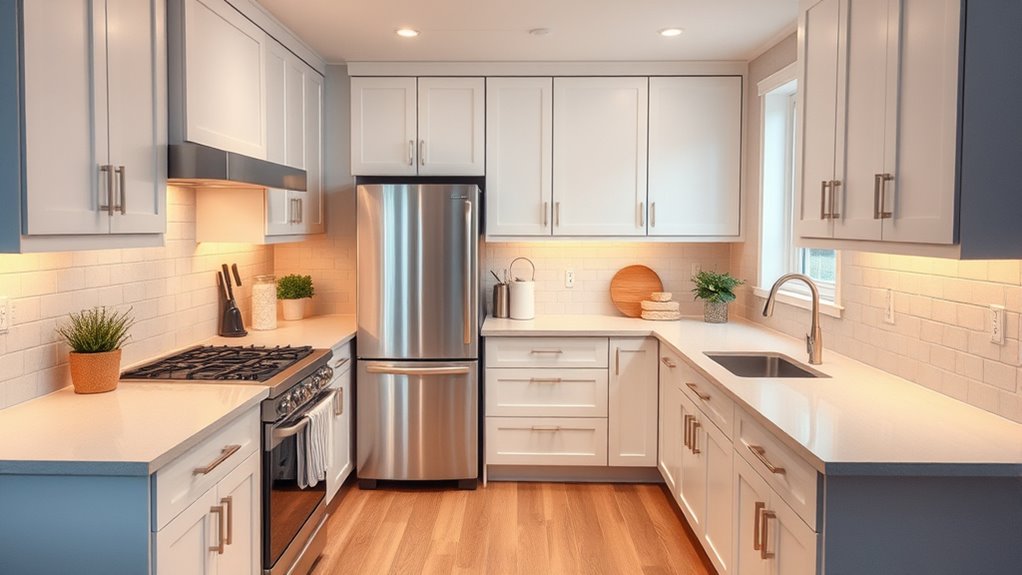
You need enough clear counter space to move comfortably and work safely. Adjustable work surfaces make tasks easier, especially when reaching items at different heights. Organized storage access makes sure everything is within reach, reducing unnecessary movement and strain. Incorporating ergonomic tools can further enhance comfort and efficiency during kitchen tasks.
Clear Counter Zones
Have you ever struggled to find enough space to prepare food comfortably? It’s common when counter clutter piles up or appliances are poorly placed. To create clear counter zones, start by organizing your workspace to keep essential items within reach but out of the way. Remove unnecessary clutter that blocks your prep area, making sure there’s enough open space for chopping, mixing, and assembling. Pay attention to appliance placement; keep frequently used appliances nearby but not crowding your work surface. A clutter-free counter reduces the risk of accidents and makes cooking more enjoyable. Clear zones help you move smoothly from task to task, minimizing reaching and bending. Regularly tidy your counters to maintain this open, accessible workspace for safer, more efficient cooking. Additionally, ensuring your workspace has color accuracy can help you see ingredients and tools clearly, reducing mistakes and enhancing safety during food prep.
Adjustable Work Surfaces
Ever find yourself stretching or bending awkwardly to reach your workspace? Adjustable work surfaces can help by providing the right height for comfortable cooking and prep. Consider countertops with height-adjustable features or modular surfaces that can be raised or lowered as needed. This flexibility reduces strain and makes tasks easier, especially if you have limited mobility. Smart appliances integrated into adjustable surfaces can streamline your workflow, offering quick access to controls and functions. Pair these with accessible lighting controls to improve visibility without needing to reach across the counter. Having the ability to customize your workspace ensures you can work comfortably and safely, making your kitchen more senior-friendly. Properly adjusted surfaces promote independence and reduce fatigue during meal preparation. Incorporating vintage-inspired design elements into your workspace can also add charm while maintaining functionality.
Organized Storage Access
Organized storage that’s easily accessible helps maintain clear, open counter space, making kitchen tasks more efficient and safer. By using creative storage solutions, you can maximize space and reduce clutter. Consider installing pull-out shelves or Lazy Susans for easy access to pots, pans, and spices. Labeling systems help you quickly identify where items are stored, saving time and reducing frustration. Keep frequently used items within reach, ideally at waist or eye level, to minimize strain. Group similar items together to simplify finding what you need. Clear containers can also help you see contents at a glance. With organized storage and thoughtful labeling, you’ll enjoy a safer, more functional kitchen that’s easier to navigate. This setup supports your independence and streamlines your cooking routine. Empowering seniors with accessible storage solutions can significantly enhance safety and ease of use in the kitchen.
Incorporating Safety Features and Ergonomic Design
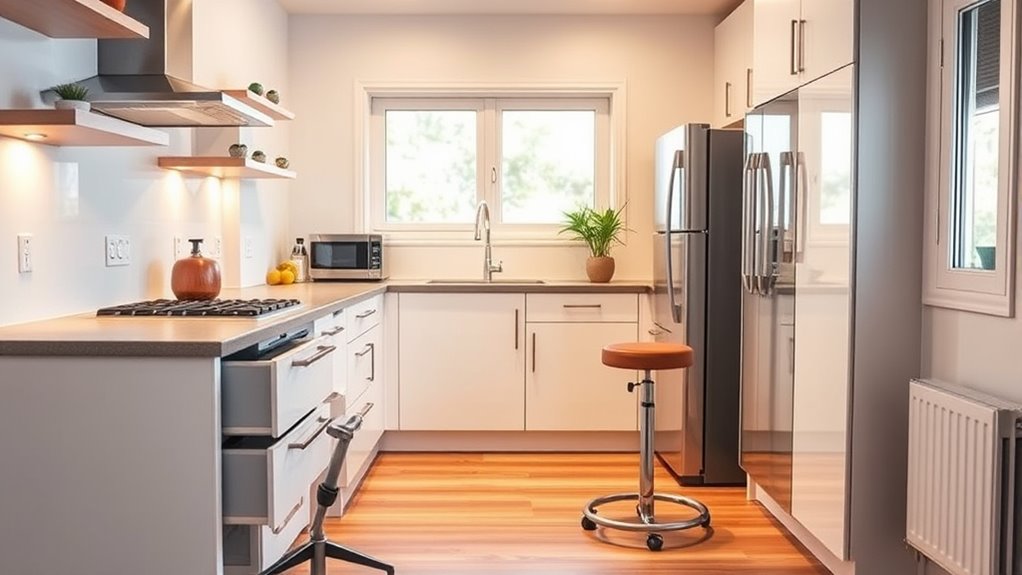
To make your kitchen safer and more comfortable, consider adding non-slip flooring to prevent falls and choosing easy-to-reach storage to reduce strain. Adjustable work surfaces let you customize the height for better comfort and safety during food prep. These features help create an ergonomic space that supports your needs and minimizes risks. Incorporating AI-driven safety features can further enhance the security and efficiency of your kitchen environment.
Non-slip Flooring Solutions
Are your kitchen floors safe and supportive enough for easy movement? Ensuring safety starts with slip-resistant solutions. Consider installing textured tiles, which provide better traction and reduce the risk of slips, especially in areas prone to spills. Additionally, adding slip resistant mats in high-traffic zones like near the sink or stove adds an extra layer of security. These mats help prevent falls by offering a cushioned, stable surface underfoot. Choose mats with non-slip backing to keep them securely in place. Combining textured tiles with slip resistant mats creates a safer, more ergonomic environment, making it easier for seniors to move confidently through the kitchen. Prioritizing these flooring solutions minimizes accidents and promotes independence during cooking and cleaning tasks. For optimal safety, selecting high-performance ratings can ensure the flooring remains reliable and effective in various conditions.
Easy-to-reach Storage Options
Ensuring that storage options are easy to access is essential for creating a safe and ergonomic kitchen for seniors. Keep cabinets at a lower height so you don’t have to stretch or climb to reach items, reducing the risk of falls or strains. Opt for open shelves or pull-down mechanisms that bring items within easy reach. Drawer accessibility is also vital—install deep, smooth-gliding drawers with ergonomic handles to minimize effort and strain. Organize frequently used items at waist level, eliminating the need to bend or reach overhead. Incorporate safety features like soft-close hinges and anti-tip mechanisms to prevent injuries. Additionally, ensuring that storage spaces meet safety standards helps prevent accidents and makes your kitchen safer, more comfortable, and easier to use, supporting independence and reducing the risk of accidents.
Adjustable Work Surfaces
Adjustable work surfaces add flexibility and safety to a senior-friendly kitchen by allowing you to modify the height to suit your needs. This ergonomic feature reduces strain and minimizes fall risks. Incorporate smart appliances with adjustable features for enhanced safety and convenience. When choosing work surfaces, consider these key points:
- Use easy-to-operate controls, like touch or lever mechanisms.
- Opt for surfaces with built-in safety features, such as anti-slip coatings.
- Match color schemes that improve visibility and reduce accidents.
- Select materials that are durable and easy to clean for ongoing safety.
– Ensuring materials are easy to maintain can help prolong the safety and functionality of your kitchen surfaces.
These adaptable surfaces, combined with smart appliances and thoughtful color schemes, create a safer, more functional kitchen environment for seniors. Adjustability ensures comfort and promotes independence in daily cooking tasks.
Tips for Maintaining Flexibility and Future Adaptability
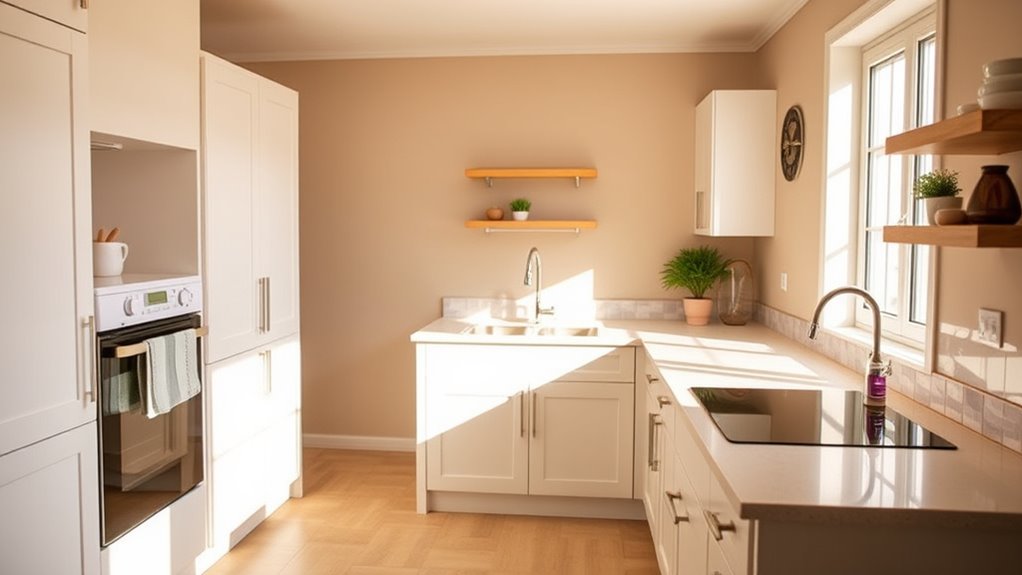
Thinking ahead can make a significant difference in maintaining a kitchen that adapts to your changing needs. Flexibility planning helps you design a space that easily accommodates future modifications. Consider installing adjustable cabinets or removable shelves so you can reconfigure storage as needed. Keep pathways clear and avoid fixed installations that limit movement or access. When choosing appliances, opt for models that are easy to upgrade or replace. Incorporate versatile features like pull-out drawers or adjustable-height surfaces to support different tasks. Regularly reassess your kitchen layout to identify areas where flexibility could improve. By planning for adaptability now, you’ll ensure your kitchen remains functional and comfortable as your needs evolve over time. Flexibility planning is key to creating a space that truly grows with you.
Frequently Asked Questions
How Can Technology Improve Safety in a Senior-Friendly Kitchen?
Technology can substantially improve safety in your senior-friendly kitchen by utilizing smart appliances and safety sensors. Smart appliances help you easily monitor and control cooking devices, reducing fire hazards. Safety sensors detect smoke, gas leaks, or water spills, alerting you immediately to prevent accidents. These innovations give you peace of mind, making your kitchen safer and more accessible, allowing you to cook confidently and independently.
What Are Cost-Effective Modifications for Aging-In-Place Kitchen Upgrades?
While luxury upgrades catch the eye, affordable upgrades and DIY modifications truly enhance your kitchen’s safety and usability as you age. You can install lever-style handles, add non-slip mats, and improve lighting easily and cost-effectively. These simple changes don’t require expert help, making your kitchen safer without breaking the bank. Embrace these practical, budget-friendly steps to create a space that’s both functional and comfortable for years to come.
How Do You Balance Aesthetics With Accessibility in Kitchen Design?
Balancing aesthetics with accessibility means choosing kitchen color schemes that brighten the space without sacrificing functionality. Opt for neutral or soft hues to create a welcoming atmosphere while ensuring good contrast for visibility. Select countertop materials like quartz or laminate that are durable and easy to clean, blending style with practicality. You can maintain a beautiful look and improve safety by integrating accessible features seamlessly into your design, making your kitchen both attractive and functional.
What Are Common Mistakes to Avoid When Designing for Seniors?
Imagine designing a space where safety and independence dance together. You should avoid common mistakes like choosing countertops that are too high or too low, which can cause strain. Be careful with appliance placement—ensure everything’s within easy reach to prevent accidents. Neglecting these details can turn a functional kitchen into a hazard. Keep accessibility in mind, and you’ll create a space that’s both practical and safe for seniors.
How Can Lighting Be Optimized for Reduced Vision in Seniors?
To optimize lighting for reduced vision in seniors, you should focus on bright, even illumination. Use under cabinet illumination to brighten workspace areas and prevent shadows. Incorporate task lighting directly over key zones like the sink and stove, ensuring they’re well-lit. Avoid glare by choosing fixtures with diffusers and warm bulbs. This setup helps seniors see clearly, reduces eye strain, and makes kitchen tasks safer and more comfortable.
Conclusion
Think of your kitchen as a well-tuned symphony, where every instrument plays in harmony. By designing your space with the senior-friendly work triangle, you create a melody of safety, convenience, and comfort. When each appliance and counter is in its perfect place, your kitchen becomes a graceful dance floor. With thoughtful planning and adaptable features, you’ll guarantee this dance continues effortlessly for years to come. Your kitchen, like a timeless song, remains beautiful and functional.
